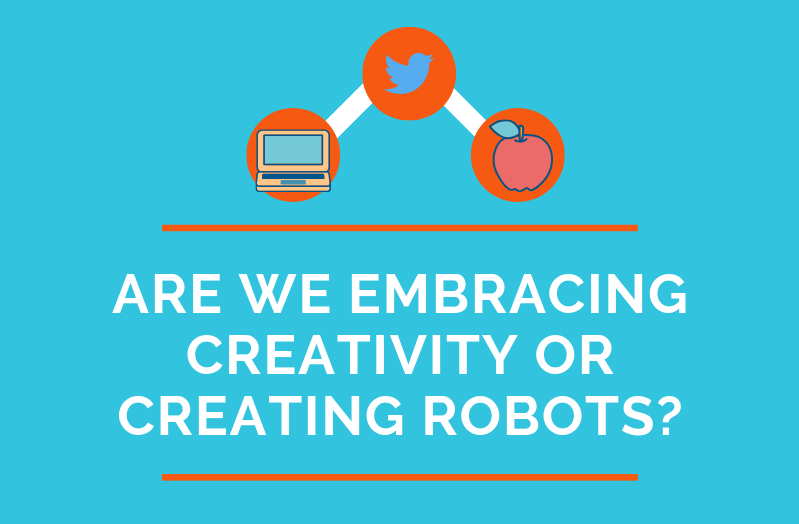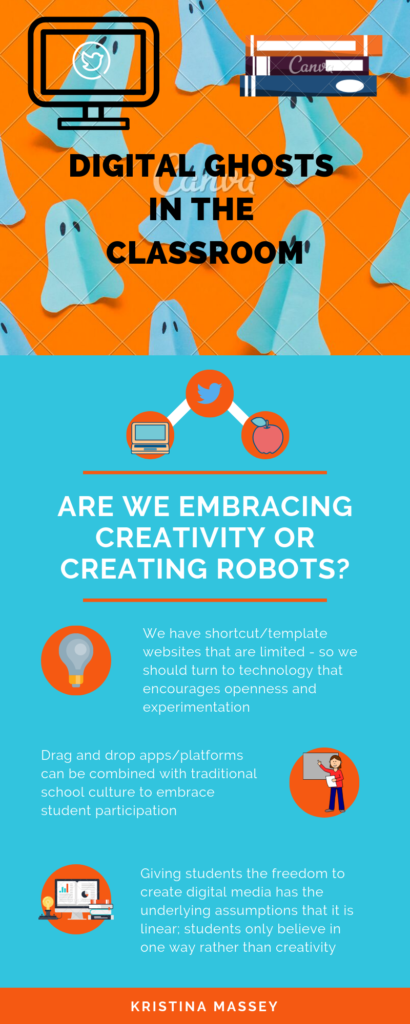
For this assignment, my infographic is based off of Ashley Hinck’s Digital Ghosts in the Modern Classroom. Hinck raises the argument about class structure and missing technologies from classrooms. Digital skills are becoming an increasing importance for jobs – and today’s students know this.

The above question is crucial to our classrooms. With the given class structure, students today are still experiencing what I did years ago. The same assessment after assessment to the final exam. Some students (like myself) found comfort in the rigid structure while those more creative struggled with this concept. Are we embracing creativity or creating robots to “drag and drop in a rigid structure to achieve a static goal?” (Lee Skallerup Bessette). Hinck, argues that we are potentially risking students creating something else envisioned or they learn to create, compose and make. (2018).

The major drawback from digital media in today’s society is the limitation of creativity. However, the ease and practicality of such websites have the appeal. Today’s teachers stray away from new digital technologies in their classrooms. We are still very comfortable using PowerPoint or Prezi. Hinck wants us as educators to switch from Canva to Photoshop or Gimp, since the assumptions (templates) under Canva are thriving. We can barely embrace creativity in scenarios like this.
Now that begs the question, should we leave these classics behind?

Technology was accessible during my time as a student, but no where near it is today. I feel that tradition is to blame. Once teachers find which technologies work for them (and not necessarily digital!), they tend to stick to it. Comparing my math classes in high school to the current digital technologies available, I will try to incorporate some of these in my practicum. We are still missing some technologies from the classroom, such as platforms and websites. We should be making students creators, makers and speakers. After all, they are our future.

Students draw on past experiences from school and the digital world in their personal life. Student teachers will also draw on past experiences in their classrooms. The linear thinking towards digital technology is a generational thing. We want to stray away from the linear thinking and make it abstract. Students are hindered by their own thoughts of failure. One way we can curb this is to show them our own failures. Give the students permission to try and fail and revise. They can collaborate to try to figure out what went wrong, instead of being afraid of being wrong. We all need to step out of our comfort zones – including me. Creativity is not my strong suit but I am glad I was able to create this Canva infographic.

Overall with this assignment, it was my first time using or even hearing about Canva. I thought it was quite ironic for me to use a template website to complete my infographic. I can personally relate to the linear way of thinking opposed to creativity. I actually made two different infographics; the first one following a rigid template with very little room for my own input. This infographic I am sharing with you today is still supplied from a Canva template, but I found more creative identity with this one. Thanks for reading!
